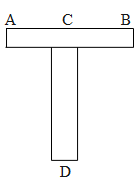
Two identical thin uniform rods of length L each are joined to form T shape as shown in the figure. The distance of the centre of mass from D is

$\begin{align}
& (1)0 \\
& (2)\dfrac{L}{4} \\
& (3)\dfrac{3L}{4} \\
& (4)L \\
\end{align}$

Answer
498.9k+ views
Hint : We know that the centre of mass of a body is the point where the whole mass of the body is concentrated. Thus for a system of particles this point is called the point of centre of mass. Thus in order to find the centre of mass of a T shaped rod, then first we have to find the centre of mass of the individual rod. Then find the centre of mass along the vertical rod, we will get the solution.
Complete step-by-step solution:
Given that the length of the rod is L. Hence its centre of mass lies at the half length $\dfrac{L}{2}$.
The centre of mass along the vertical line is,
\[{{y}_{CM}}=\dfrac{{{m}_{1}}{{y}_{1}}+{{m}_{2}}{{y}_{2}}}{{{m}_{1}}+{{m}_{2}}}\]
\[{{y}_{CM}}=\dfrac{0+\dfrac{mL}{2}}{2m}\]
\[{{y}_{CM}}=\dfrac{L}{4}\]
Hence here the centre of mass of the system lies at the lower end of the rod. Thus The distance of the centre of mass from D is $\dfrac{L}{4}$.
Therefore option (2) is correct.
Note: So we calculate the centre of mass of every object by simply knowing their masses and multiplying them by their positions. Besides the pure geometric method we can also find the centre of gravity of any object by the plum line method. For a sphere of uniform density the centre of mass lies at the geometric centre of the sphere.
Complete step-by-step solution:
Given that the length of the rod is L. Hence its centre of mass lies at the half length $\dfrac{L}{2}$.
The centre of mass along the vertical line is,
\[{{y}_{CM}}=\dfrac{{{m}_{1}}{{y}_{1}}+{{m}_{2}}{{y}_{2}}}{{{m}_{1}}+{{m}_{2}}}\]
\[{{y}_{CM}}=\dfrac{0+\dfrac{mL}{2}}{2m}\]
\[{{y}_{CM}}=\dfrac{L}{4}\]
Hence here the centre of mass of the system lies at the lower end of the rod. Thus The distance of the centre of mass from D is $\dfrac{L}{4}$.
Therefore option (2) is correct.
Note: So we calculate the centre of mass of every object by simply knowing their masses and multiplying them by their positions. Besides the pure geometric method we can also find the centre of gravity of any object by the plum line method. For a sphere of uniform density the centre of mass lies at the geometric centre of the sphere.
Recently Updated Pages
Why are manures considered better than fertilizers class 11 biology CBSE

Find the coordinates of the midpoint of the line segment class 11 maths CBSE

Distinguish between static friction limiting friction class 11 physics CBSE

The Chairman of the constituent Assembly was A Jawaharlal class 11 social science CBSE

The first National Commission on Labour NCL submitted class 11 social science CBSE

Number of all subshell of n + l 7 is A 4 B 5 C 6 D class 11 chemistry CBSE

Trending doubts
What is meant by exothermic and endothermic reactions class 11 chemistry CBSE

10 examples of friction in our daily life

One Metric ton is equal to kg A 10000 B 1000 C 100 class 11 physics CBSE

1 Quintal is equal to a 110 kg b 10 kg c 100kg d 1000 class 11 physics CBSE

Difference Between Prokaryotic Cells and Eukaryotic Cells

What are Quantum numbers Explain the quantum number class 11 chemistry CBSE




